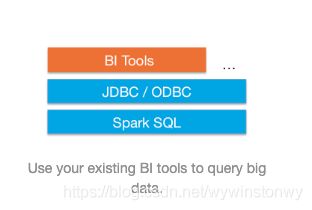PySpark之Spark SQL的使用《七》
一、Spark SQL简介
Spark SQL is Apache Spark's module for working with structured data.
Spark SQL是一个用于结构化数据处理的Spark模块。与基本的Spark RDD API不同,Spark SQL提供的接口为Spark提供了有关数据结构和正在执行的计算的更多信息。在内部,Spark SQL使用这些额外的信息来执行额外的优化。有几种与Spark SQL交互的方法,包括SQL和Dataset API。当计算结果时,使用的是相同的执行引擎,与表示计算所用的API/语言无关。这种统一意味着开发人员可以很容易地在不同的api之间来回切换,这些api提供了表达给定转换的最自然的方式。
本页上的所有示例都使用Spark发行版中包含的示例数据,可以在Spark -shell、pyspark shell或sparkR shell中运行。
-
Integrated《集成》
SQL查询与Spark程序无缝结合。
Spark SQL允许您使用SQL或熟悉的DataFrame API在Spark程序中查询结构化数据。适用于Java、Scala、Python和R语言。
results = spark.sql(
"SELECT * FROM people")
names = results.map(lambda p: p.name)
Apply functions to results of SQL queries.-
Uniform Data Access《统一的数据访问》
以同样的方式连接到任何数据源。
DataFrames和SQL提供了一种通用的方法来访问各种数据源,包括Hive、Avro、Parquet、ORC、JSON和JDBC。您甚至可以跨这些源联接数据。
spark.read.json("s3n://...")
.registerTempTable("json")
results = spark.sql(
"""SELECT *
FROM people
JOIN json ...""")-
Hive Integration《整合Hive》
在现有仓库上运行SQL或HiveQL查询。
Spark SQL支持HiveQL语法以及Hive SerDes和udf,允许您访问现有的Hive仓库。
-
Standard Connectivity《标准的连接》
通过JDBC或ODBC连接。
服务器模式为商业智能工具提供了行业标准的JDBC和ODBC连接。
二、Spark SQL操作
-
spark sql基础操作
from pyspark.sql import SparkSession
from pyspark.sql import Row
from pyspark.sql.types import *
#spark Sql 基础操作
def test():
# spark = SparkSession.builder.appName('spark005').getOrCreate()
spark = SparkSession \
.builder \
.appName("Python Spark SQL basic example") \
.config("spark.some.config.option",
"some-value") \
.getOrCreate()
df = spark.read.json('file:///Users/wangyun/Documents/BigData/script/data/people.json')
df.show()
df.printSchema()
df.select('name').show()
df.select(df['name'], df['age'] + 1).show()
df.filter(df['age'] > 21).show()
# Count people by age
df.groupBy("age").count().show()
print('createOrReplaceTempView')
df.createOrReplaceTempView("people")
sqlDF = spark.sql("SELECT * FROM people")
sqlDF.show()
spark.stop()
运行结果:
To adjust logging level use sc.setLogLevel(newLevel). For SparkR, use setLogLevel(newLevel).
+----+-------+
| age| name|
+----+-------+
|null|Michael|
| 30| Andy|
| 19| Justin|
+----+-------+
root
|-- age: long (nullable = true)
|-- name: string (nullable = true)
+-------+
| name|
+-------+
|Michael|
| Andy|
| Justin|
+-------+
+-------+---------+
| name|(age + 1)|
+-------+---------+
|Michael| null|
| Andy| 31|
| Justin| 20|
+-------+---------+
+---+----+
|age|name|
+---+----+
| 30|Andy|
+---+----+
+----+-----+
| age|count|
+----+-----+
| 30| 1|
| 19| 1|
|null| 1|
+----+-----+
createOrReplaceTempView
+----+-------+
| age| name|
+----+-------+
|null|Michael|
| 30| Andy|
| 19| Justin|
+----+-------+
Process finished with exit code 0
Spark SQL支持两种不同的方法将现有的RDDs转换为数据集。第一种方法使用反射来推断包含特定对象类型的RDD的模式。这种基于反射的方法使代码更简洁,当您在编写Spark应用程序时已经了解模式时,这种方法可以很好地工作。
创建数据集的第二种方法是通过编程接口,该接口允许您构造模式,然后将其应用于现有的RDD。虽然此方法更详细,但它允许您在列及其类型直到运行时才知道时构造数据集。
-
rdd转化schemedataframe
Spark SQL可以将Row对象的RDD转换为DataFrame,从而推断数据类型。行是通过将一组键/值对作为kwargs传递给Row类来构造的。这个列表的键定义表的列名,类型通过对整个数据集进行采样来推断,类似于对JSON文件执行的推断。
from pyspark.sql import SparkSession
from pyspark.sql import Row
from pyspark.sql.types import *
def schemeReflection():
spark = SparkSession \
.builder \
.appName("Python Spark SQL basic example") \
.config("spark.some.config.option",
"some-value") \
.getOrCreate()
sc = spark.sparkContext
lines = sc.textFile(
"file:///Users/wangyun/Documents/BigData/script/data/people.txt")
parts = lines.map(lambda l: l.split(","))
print(parts.collect())
people = parts.map(
lambda p: Row(name=p[0], age=int(p[1])))
# Infer the schema, and register the DataFrame as a table.
schemaPeople = spark.createDataFrame(people)
schemaPeople.createOrReplaceTempView("people")
# SQL can be run over DataFrames that have been registered as a table.
teenagers = spark.sql(
"SELECT name FROM people WHERE age >= 13 AND age <= 19")
# The results of SQL queries are Dataframe objects.
# rdd returns the content as an :class:`pyspark.RDD` of :class:`Row`.
teenNames = teenagers.rdd.map(
lambda p: "Name: " + p.name).collect()
for name in teenNames:
print(name)
# Name: Justin-
使用反射推断模式
Spark SQL可以将Row对象的RDD转换为DataFrame,从而推断数据类型。行是通过将一组键/值对作为kwargs传递给Row类来构造的。这个列表的键定义表的列名,类型通过对整个数据集进行采样来推断,类似于对JSON文件执行的推断。
#创建scheme作用于rdd
def programmascheme():
spark = SparkSession \
.builder \
.appName("Python Spark SQL basic example") \
.config("spark.some.config.option",
"some-value") \
.getOrCreate()
sc = spark.sparkContext
# Load a text file and convert each line to a Row.
lines = sc.textFile(
"file:///Users/wangyun/Documents/BigData/script/data/people.txt")
parts = lines.map(lambda l: l.split(","))
# Each line is converted to a tuple.
people = parts.map(
lambda p: (p[0], p[1].strip()))
# The schema is encoded in a string.
schemaString = "name age"
fields = [
StructField(field_name, StringType(),
True) for field_name in
schemaString.split()]
schema = StructType(fields)
# Apply the schema to the RDD.
schemaPeople = spark.createDataFrame(people,
schema)
# Creates a temporary view using the DataFrame
schemaPeople.createOrReplaceTempView("people")
# SQL can be run over DataFrames that have been registered as a table.
results = spark.sql("SELECT name FROM people")
results.show()
results = spark.sql("SELECT * FROM people")
results.show()
相关推荐:
hadoop,pySpark环境安装与运行实战《一》
Spark RDD操作,常用算子《二》
PySpark之算子综合实战案例《三》
Spark运行模式以及部署《四》
Spark Core解析《五》
PySpark之Spark Core调优《六》
PySpark之Spark SQL的使用《七》

